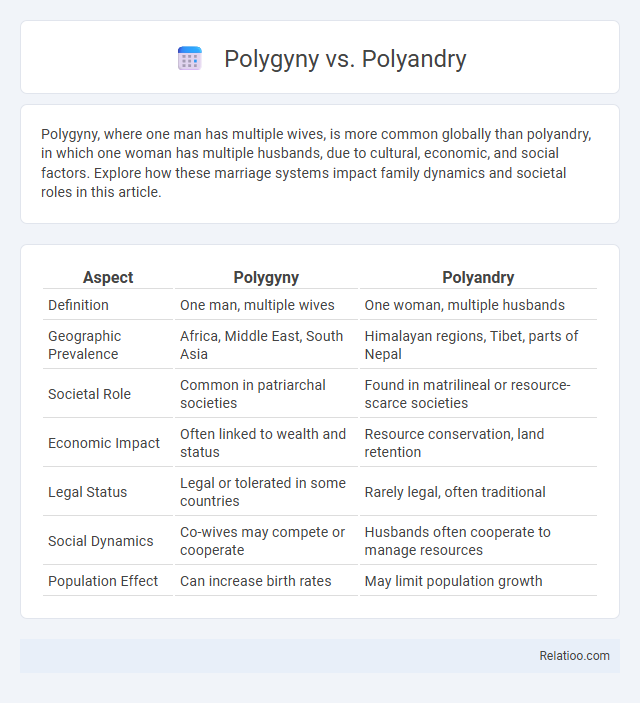Polygyny, where one man has multiple wives, is more common globally than polyandry, in which one woman has multiple husbands, due to cultural, economic, and social factors. Explore how these marriage systems impact family dynamics and societal roles in this article.
Table of Comparison
| Aspect | Polygyny | Polyandry |
|---|---|---|
| Definition | One man, multiple wives | One woman, multiple husbands |
| Geographic Prevalence | Africa, Middle East, South Asia | Himalayan regions, Tibet, parts of Nepal |
| Societal Role | Common in patriarchal societies | Found in matrilineal or resource-scarce societies |
| Economic Impact | Often linked to wealth and status | Resource conservation, land retention |
| Legal Status | Legal or tolerated in some countries | Rarely legal, often traditional |
| Social Dynamics | Co-wives may compete or cooperate | Husbands often cooperate to manage resources |
| Population Effect | Can increase birth rates | May limit population growth |
Understanding Polygyny and Polyandry
Polygyny refers to a marriage system where one man has multiple wives, often practiced in various cultures for economic or social reasons. Polyandry involves one woman having multiple husbands, a rare arrangement primarily found in certain Himalayan societies to preserve family land. Understanding these distinctions helps you grasp how polygyny and polyandry shape family structures and social dynamics differently within the broader context of polygamy.
Historical Origins of Polygyny and Polyandry
Polygyny, historically rooted in ancient agricultural and pastoral societies, allowed men to marry multiple wives to increase labor force and offspring survival, while polyandry, found in resource-scarce Himalayan regions, enabled women to have multiple husbands to limit family land division and ensure economic stability. Polygamy, encompassing both polygyny and polyandry, emerged from diverse cultural, social, and ecological conditions shaping marital practices globally. Understanding your exploration of these marriage systems reveals their complex interplay with societal structures and environmental demands over time.
Cultural Perspectives on Marital Structures
Polygyny, the practice of one man having multiple wives, is prevalent in many African and Middle Eastern cultures, often symbolizing wealth and social status. Polyandry, where one woman has multiple husbands, is rare but historically observed in Himalayan societies to preserve land and limit population growth. Polygamy encompasses both forms and reflects diverse cultural norms shaping family dynamics, inheritance rules, and gender roles across societies globally.
Legal Status Around the World
Polygyny, polyandry, and polygamy refer to different forms of plural marriages, with polygyny involving one man and multiple wives, polyandry one woman and multiple husbands, and polygamy encompassing both practices. Legal status varies widely: polygyny is legally recognized or tolerated in parts of Africa, the Middle East, and Asia, while polyandry is rare and mostly unrecognized worldwide. Your understanding of these marital structures must consider that most Western countries outlaw any form of polygamy, enforcing strict monogamy laws.
Demographic and Social Impacts
Polygyny, involving one man with multiple wives, often leads to skewed sex ratios and increased competition among men, affecting social stability and marriage market dynamics. Polyandry, where one woman has multiple husbands, can limit population growth and reshape inheritance patterns, impacting familial structures and economic cooperation. Your understanding of these practices highlights their distinct demographic effects and complex social ramifications in various cultures.
Gender Roles in Polygynous and Polyandrous Societies
In polygynous societies, where one man has multiple wives, gender roles typically emphasize male authority, with men controlling resources and decision-making power, while women focus on domestic responsibilities and child-rearing. Polyandrous societies, where one woman has multiple husbands, often display a reversal or blending of traditional gender roles, with men sharing labor and child-rearing duties under a predominantly female-headed household. These contrasting gender dynamics impact inheritance patterns, social status, and kinship structures within polygynous and polyandrous communities.
Economic Factors Influencing Polygamy
Economic factors play a crucial role in shaping polygamous practices, with wealth and resource distribution significantly influencing the prevalence of polygyny, where men with greater economic means often support multiple wives. In contrast, polyandry tends to emerge in resource-scarce environments, limiting the division of family wealth among brothers sharing a single wife to preserve economic stability. Polygamy as a broader practice reflects underlying socio-economic conditions, including labor demands, inheritance laws, and social status, all contributing to the varying adoption of multiple-spouse marriage systems worldwide.
Psychological Implications for Individuals
Polygyny, polyandry, and polygamy each present distinct psychological implications for individuals, often influencing emotional well-being and interpersonal dynamics. Polygyny, involving one man with multiple wives, can lead to competition and jealousy among co-wives, impacting self-esteem and mental health. Polyandry, where one woman has multiple husbands, may result in complex paternal roles and identity challenges, while polygamy as a broader term encompasses these forms and often raises issues related to social stigma, emotional stress, and family cohesion.
Challenges and Controversies
Polygyny, polyandry, and polygamy each present unique challenges and controversies rooted in cultural norms, legal systems, and gender dynamics. You may face complex legal issues, social stigma, and emotional conflicts, especially in regions where these practices are illegal or socially frowned upon. Gender inequality and power imbalances often fuel debates, highlighting concerns about the rights and well-being of all parties involved in such unions.
The Future of Polygynous and Polyandrous Relationships
The future of polygynous and polyandrous relationships depends on evolving social norms, legal frameworks, and cultural acceptance across global societies. Advances in gender equality, digital matchmaking, and decriminalization efforts may influence increased visibility and viability of both polygyny and polyandry. Research on family dynamics, psychological outcomes, and economic impacts will shape policies and societal attitudes toward polygamous family structures.

Infographic: Polygyny vs Polyandry
 relatioo.com
relatioo.com